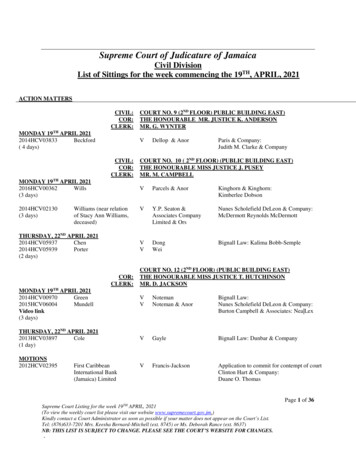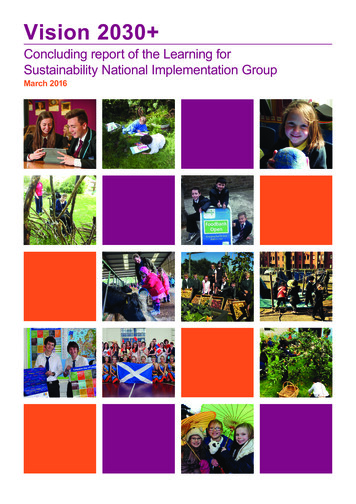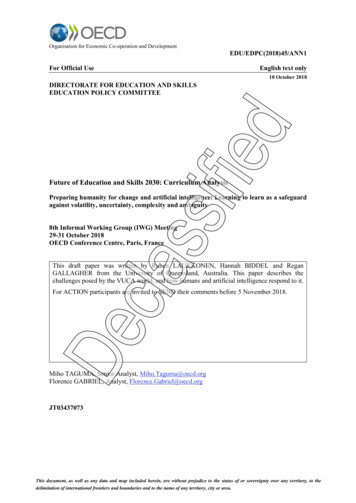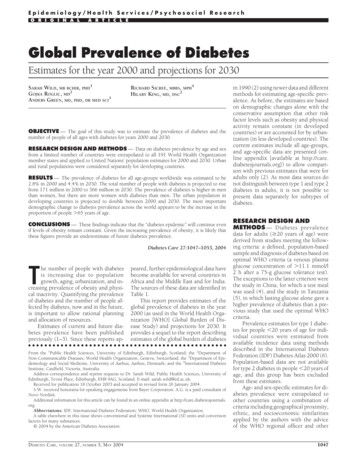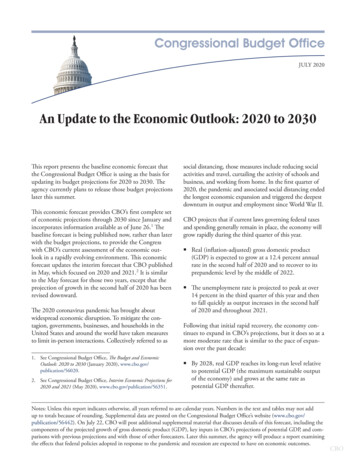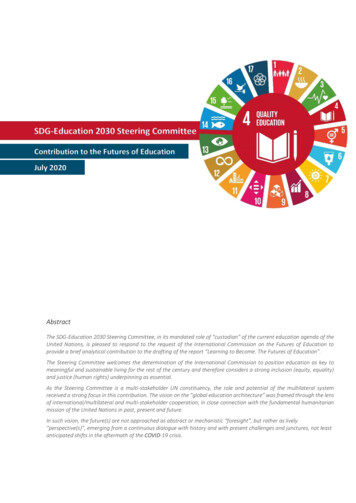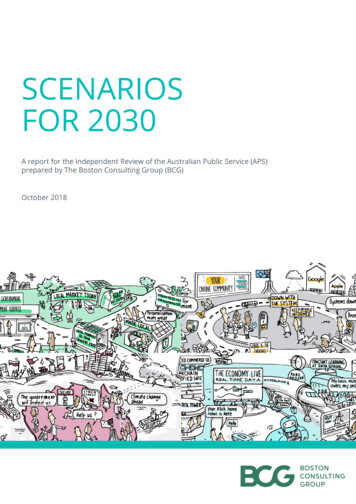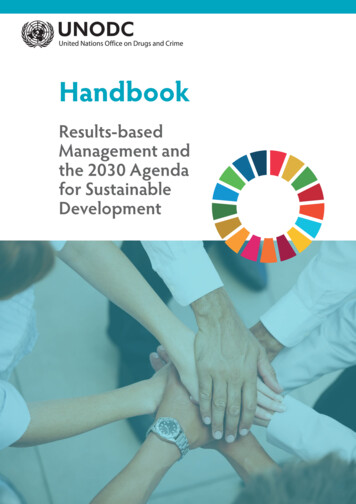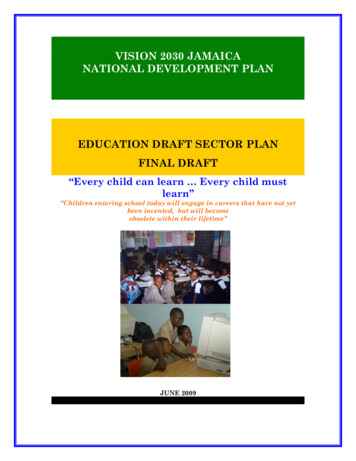
Transcription
VISION 2030 JAMAICANATIONAL DEVELOPMENT PLANEDUCATION DRAFT SECTOR PLANFINAL DRAFT“Every child can learn Every child mustlearn”“Children entering school today will engage in careers that have not yetbeen invented, but will becomeobsolete within their lifetime”JUNE 2009
EditedOctober2009EDUCATIONSECTOR PLAN2009 - 20301
Table of ContentsSection 1 - IntroductionPage #3Section 2 – Situational Analysis6Background and Context6Major Achievements in Education8Key Issues and Challenges9Financing Education10Population and Demographics of the Education14SystemThe Institutional and Legislative Framework17Analysis of the Education System by Level18Section 3 – SWOT Analysis39Section 4 – Strategic Vision and Planning Framework44Section 5 – Implementation Framework and Action Plan47Section 6 - Monitoring and Evaluation Framework71List of Acronyms75Appendices77
SECTION 1- INTRODUCTIONEducation and training are emerging as key drivers of a country’s competitiveness1.The world is characterised by rapid change, increasing globalisation and growingcomplexity in terms of economic and socio-cultural relations. The speed of these changesprovides a context within which the future objectives of education and training systemsmust be placed. Globally, many countries are transforming their education systems andestablishing increasingly ambitious and challenging goals. For example, Cuba hasdecided to aim for university level education for its entire population, while in Trinidadevery child has access to free education at all levels, and the vision for Barbados is tohave one tertiary trained person in every household by 2020. In New Zealand educationhas moved from a mainly centralized structure to one in which individual schools andtertiary institutions are largely responsible for their own governance and management,working within the framework of guidelines, requirements and funding arrangements setby central government and administered through its agencies.The educational level of a country is a determinant of the stage of its economicdevelopment and potential for future growth. Investment in education is important,enabling the development of each person’s full potential and consequently creating acompetitive workforce. Education is therefore a social indicator of a country’s economicdevelopment and the stock and quality of its human capital. On an individual level,formal education is one of several important contributors to the skills and socialisation ofan individual and helps citizens to learn how to function in society and be successful inlife.The Sector Plan for Education is influenced by the guiding principles in the Vision 2030Jamaica -National Development Plan and is based on a shared vision of placing Jamaicaprominently on the global map in terms of excellence in education. The Plan will build onwork already undertaken by the Task Force on Education Transformation. It recognizesthe importance of the integration between education and training. However, the analysis1World Economic Forum, Global Competitiveness Report 20063
in this plan focuses on the formal and non-formal educational programmes from preprimary to tertiary. Another plan, focusing on Training and Workforce Development,targets the training institutions and programmes including training activities of secondaryschools, post-secondary and tertiary institutions in preparation for the labour market.This Sector Plan is one of thirty one that form the foundation for the development ofVision 2030 Jamaica National Development Plan - a long term Plan designed to putJamaica in a position to achieve developed country status by 2030. Vision 2030 Jamaicais based on a fundamental vision to make “Jamaica the place of choice to, live, work,raise families and do business”, and on guiding principles which put ‘people’ at thecentre of Jamaica’s transformation. Twelve strategic priorities have been identified ascritical elements in fulfilling the objectives of the plan. The Vision statement for thisSector Plan is: “Well resourced, internationally recognised, values based system thatdevelops critical thinking, life-long learners who are productive and successful andeffectively contribute to an improved quality of life at the personal, national and globallevels”. This Vision focuses on facilitating equality of opportunities, social cohesion andpartnerships. The Plan envisages that the average beneficiary of our education andtraining system will have completed the secondary level of education, acquired avocational skill, be proficient in the English Language, a foreign language, Mathematics,a science subject, Information Technology, participated in sports and the arts, be awareand proud of our local culture and possess excellent interpersonal skills and workplaceattitudes.The preparation of the Education Sector Plan has been supported by a quantitativesystems dynamics model – Threshold 21 Jamaica (T21 Jamaica) – which supportscomprehensive, integrated planning that enables the integration of a broad range ofinterconnected factors inclusive of economic, social and environmental considerations.The T21 Jamaica is able to project future consequences of different strategies across arange of indicators. In addition, it will enable planners to trace causes of changes in anyvariable or indicator back to the assumptions.4
The first draft of this Sector Plan was developed using the following processes:1. Task Force Meetings to solicit ideas and views from members2 on issues andchallenges facing the educational sector in Jamaica as well as identifying a visionfor Education in Jamaica, and determining key goals, objectives and strategies forthe sector;2. building on the work undertaken by the Education Transformation Task Force andadopting the goals and objectives contained therein - the initiatives of thetransformation programme are centred on improving quality, equity and access.The activities include the modernization of the Ministry of Education (MOE), thedecentralising of the administration of the school system, improvement in teacherquality, provision of additional school spaces, reduction in teacher-pupil ratio,improvement in quality assurance and increased stakeholder participation. Theseactivities are scheduled to be accomplished by 2016;3. research on international best practices and experiences from other developed anddeveloping countries including Australia, New Zealand, Japan, Cuba, the UnitedKingdom and the United States of America in education that could be adopted inthe Jamaican context;4. a strategic meeting between the Chair of the Task Force, Chairman of the PAG,the consultant and the Technical Secretary of the PIOJ;5. a strategic meeting with the Chair of the Education Task Force and the Chair ofthe Training & Workforce Development Task Force towards identifying crosscutting issues and synchronization of the planning process; and6. a strategic meeting with the Executive Director of the Transformation Team andhis work stream leaders as well as members of the PIOJ’s National DevelopmentPlanning team towards integrating activities of the Education Transformationprogramme with the National Development planning process.This document includes the primary elements listed below:2 Situational Analysis SWOT Analysis Strategic Vision and Planning Framework (including vision, goals, Outcomes andSee Appendix 1 for List of Members of the Education Task Force.5
Indicators) Implementation Framework and Action Plan Monitoring and Evaluation FrameworkSECTION 2 - SITUATIONAL ANALYSISBackground and ContextThe Government has recognized the responsibility to ensure that every Jamaican childhas a right to education to the level and extent possible within the resources of the State.Demands on education are growing. Rapid technological change and the move towards aknowledge-based society has necessitated a reassessment of the content and delivery ofeducation to better face the challenges of the 21st century. Demands for educationalopportunities also are growing – participation in education has been increasing steadilydue to population growth, higher rates of primary completion, demands from industry fora higher trained workforce; and a perception of the positive gains from progressing to andcompleting secondary- and tertiary-level programmes.Education in Jamaica is administered primarily by the Ministry of Education (MOE),through its head office and six regional offices. Formal education is provided mainly bythegovernment,solelyorinpartnerships with churches and trusts.Formal education also is provided byprivateschools.Basedonthestipulation of the Education Act(1980), the education system consistsof four levels:1. Early Childhood2. Primary3. Secondary4. Tertiary6
The education system caters to approximately 788,000 students in public and privateinstitutions at the early childhood, primary, secondary and tertiary levels.The current education system is pursuing the following seven strategic objectives to:1. devise and support initiatives that are directed towards literacy for all, and in thisway, extend personal opportunities and contribute to national development;2. secure teaching and learning opportunities that will optimize access, equity andrelevance throughout the education system;3. support student achievement and improve institutional performance in order toensure that national targets are met;4. maximize opportunities within the Ministry’s purview that promote culturaldevelopment, awareness and self-esteem for individuals, communities and thenation as a whole;5. devise and implement systems of accountability and performance management toimprove performance and win public confidence and trust;6. optimize the effectiveness and efficiency of staff in all aspects of the service toensure continuous improvement in performance;7. enhance student learning by increasing the use of information and communicationtechnology in preparation for life in the national and global communities.Funding for education is provided primarily by the Government of Jamaica throughallocations from the budget. According to GLOBUS, in 2001 Jamaica had the 8th highesteducation expenditure (6.8%) as a percentage of GDP worldwide. Only two developedcountries – New Zealand & Sweden – ranked higher than Jamaica in this regard. As apercentage of the National budget, Jamaica ranks below Caribbean countries such asTrinidad and Tobago and Barbados.In 2006, the Government began implementation of the recommendations of the NationalEducation Task Force as well as introducing a number of programmes and projectstowards improving quality, equity and access in the education system. This reform isexpected to improve Jamaica’s human capital and produce the skills necessary for7
Jamaican citizens to compete in the global economy. The Task Education Task Forceincluded the establishment of Regional Education Authorities and the Restructuring ofthe Ministry of Education as one of its main recommendations.Major Achievements in EducationMany initiatives and policies have been implemented at all levels of the education systemin order to improve the offering and outcomes of educational achievements in Jamaica.Some of these include:1. universal access to early childhood, primary and the early grades (7-9) of thesecondary level;2. development of standards to guide the delivery of early childhood education,including the establishment of the Early Childhood Commission;3. national standardized textbooks and workbooks, provided free of cost at theprimary level;4. addressing some of the demand for spaces in the secondary schools byconstructing over 17 schools during the period 2005 – 2007, to generate over16,000 spaces;5. a highly subsidized and accessible book rental scheme at the secondary level;6. a highly subsidized lunch programme;7. a standardized national primary curriculum;8. the heightening of participation by civil society in the education process, resultingin additional funds being provided for the system;9. a revolving loan scheme (J 600-million) for professional development ofteachers;10. production and delivery of student and teacher furniture amounting to over250,000 units over the period 2005-2007;11. development and building standards for the school infrastructure system for over400 schools;12. refunding of tuition to teachers;13. training of principals in Principles of Management at UWI;14. repairs to over 400 schools over the period 2005-2007;8
15. development and implementation of a series of educational policies including anICT policy for Education, a Language Education Policy, a Mathematics andNumeracy Policy, a National Policy for HIV/AIDS Management in Schools and aSpecial Education Policy (see Appendix 4 for ICT Policy); and16. execution of the JET programme centred on improving the surroundings ofschools at all levels while educating the students of the need to take care of theirenvironment. (The Jamaica Environment Trust programme is a non-governmentalorganisation which has become a part of the school environmental plan in over200 schools island-wide. Currently, JET is financed by the EducationTransformation Project, the MOE and the Private Sector).Despite all these achievements, the system’s performance is well below acceptablestandards, manifested in low student performance. Data from the PIOJ reveal that in2006, some 35 per cent of primary school leavers were illiterate, and only about 26 percent3 of secondary graduates had the requisite qualification for meaningful employmentand/or entry to post secondary programmes.Key Issues and ChallengesThe educational system has been heavily criticised. The criticisms centre around thequality of graduates from government funded or co-funded institutions; the examinationsuccess rate of students at all levels of the system; and the high rate ofilliteracy among individuals who have benefited from ourschool system. These outcomes have been linked to a rangeof weaknesses in the system including: insufficient access to quality facilities particularlyat the pre-primary, primary and secondary levels; inadequacy of space particularly at the upper secondary andmore so, tertiary levels;3CXC Statistical Bulletin, 2006.9
performance targets, set in the Ministry, are not sufficiently cascaded throughoutthe system which results in little or no accountability for performance at thevarious levels; inadequate number of university trained teachers for all levels; inadequate number of trained teachers at the pre-primary level; negligible use of educational technology at all levels; use of teacher-centred teaching methods at the early levels; the inability of some parents to afford the fees charged under the Cost Sharingscheme, despite the “no child should be left behind” policy4; inadequate facilities to accommodate students with special needs (e.g. physicallyand mentally challenged students as well as the gifted); inadequate involvement of parents5 in the education of their children; the under performance of boys compared to girls at all levels of the schoolsystem; anti-social behaviour and increased violence in schools; and inadequate managerial training among school leaders.Government continues to grapple with the aforementioned issues and how to correct thefailings. Other issues being considered include: how to recruit and retain the best teachersin the face of the recruitment of highly skilled teaching professionals in overseasjurisdictions; and the country’s inability to pay competitive salaries.Financing EducationWidening participation at higher levels of education as well as maintaining equity andeducation quality have important implications for education spending6. The Governmentof Jamaica currently spends over 40 billion (2006/07 fiscal year, representing 11.4 % of4Under this policy, no child attending a government funded institution should be refused entry on the basis of inability to pay theshared cost.5In school based (PTAs); and home-based (homework etc.) involvement.6At the primary level, the rationale for public support of education appears quite strong. Unit costs are low compared to other levels ofeducation and investment in primary education has been shown, through benefit incidence analysis, to favour the poor (World Bank,2001). Similar equity-based arguments can be made for secondary education. However, at the tertiary level, unit costs are considerablyhigher and the composition of students tends to be over-represented by those from higher income households. Since tertiary educationhas been shown to provide greater returns to the individual, governments may assign greater responsibility for funding tertiary andeven secondary education to individuals and households to reflect this shift in benefits.10
the budget or 28.0 % of the non-debt portion of the budget) on education, withhouseholds estimated to spend an additional 19 billion. Household expenditure oneducation include payments for tuition, exam and other fees, extra lessons, books,transportation, lunch & snacks and uniforms. According to the Jamaica Survey of LivingConditions (JSLC) 2006, each household was spending an average of 67,591.56 oneducation expenses. The Table below presents a breakdown of annual educationexpenditure of households between 2002 and 2006.Table 1: ANNUAL EDUCATION EXPENDITURE ( ), 2002- nExam and otherFeesExtra 33,692.8813,265.73426.72129.64715.32Lunch & 391.82r - reviseddata. Adapted from the Estimates of Expenditure, 2002-2006There also is substantial private investment in education from institutions, particularly theChurch. This budget for education is supplemented by other Government expendituresuch as deferred financing for school building and funding from the Jamaica SocialInvestment Fund (JSIF), as well as the Culture, Health, Arts, Sports and Education(CHASE) Fund. In addition, the Government has begun to foster new private and publicsector partnerships using deferred financing to create new school places at all levels. Thisarrangement is currently initiated with private companies such as WHICON and GoreDevelopments Ltd.11
The Budgetary allocation for Government funded secondary and tertiary institutions issupplemented by fees charged under Cost Sharing schemes. Institutions at the EarlyChildhood Level, apart from the public funded “Infant Schools”, are largely financedthrough tuition fees and non-government support7. Over the period 2002/03 to 2006/07,actual expenditure exceeded the approved budget by an average of 9.3 per cent (Table 2).With respect to the allocations in the budget by programmes, the largest proportion wentto Primary Education (31.8 %) and Secondary Education (28.0 %). Early Childhood wasallocated 3.3 per cent, while Tertiary received 17.0 per cent of the budget (the thirdhighest allocation). Approximately 1B per annum is paid as subsidy to basic schoolteachers.Table 2: Approved and Actual Recurrent and Capital Budget forEducation (J 000') 2002/03 – en Actualand Approved(Percentage)9.123.14.21.28.7n/aAdapted from the Estimates of Expenditure, 2002-2009According to UNESCO’s “Teachers for Tomorrow’s Schools”, the funding of a nationaleducation system should be equitably distributed across the population, with privateexpenditure playing an important role in financing secondary and tertiary education.In a number of countries around the world, parents and communities help to cover costsby directly or indirectly subsidising teachers’ salaries in state-run schools, or by directlyemploying and paying teachers. The extent of private funding of education reaches highlevels in some countries, accounting for more than 40 per cent of total educationalexpenditure in Chile, Peru, the Philippines and Thailand.7Infant Schools and departments of public primary schools are supported from GOJ budget.12
With respect to higher education, data from OECD countries indicate that within privatefinance as a whole, households spend almost twice as much as all other private entities onhigher education. Through a combination of tuition and indirect expenses, households in2003 contributed 16 per cent of total expenditure on higher education, while other privateentities (e.g., businesses, charities, and labour organizations) contributed 9 per cent. Incontrast, the Jamaican Government finances between 65 per cent and 80 per cent of thecost of higher education.Although Jamaica spends a fairly high percentage of its resources on education, it is clearthat the present levels of expenditure are inadequate and that innovative approaches tofinancing education are not fully explored. Approximately 80 per cent of the budgetaryallocation is to recurrent expenditures as opposed to learning resources. This could partlycontribute to poor student performance and quality outcomes. There is a growing viewthat investment in education is most efficiently allocated using students as the focusrather than institutions. International best practice indicates that policy, practice andadequate resources must be aligned to support not only academic learning for each child,but also the experiences that encourage development of a whole child – one who isknowledgeable, healthy, motivated and engaged.Table 3 compares the expenditure per student at the various levels of the educationsystem for Jamaica, Barbados and Trinidad and Tobago. The results indicate that Jamaicalags behind its CARICOM partners at all three levels.Table 3: Expenditure per Student for Selected Countries (US ) for year 2000 andCXC Performance for Three Key Subjects - 2003CountryPrimarySecondaryTertiaryGDP 8.353.367.3Source: UNESCO13
The high level of literacy in Barbados as well as its economic performance vis-à-visTrinidad & Tobago and Jamaica suggest some relationship between educationalexpenditure, on the one hand, and educational and economic performance on the other.However, despite the fact that Barbados spends three times as much per student asJamaica, the performance of Barbadian students at CXC is not proportionately higherthan that of Jamaican students in these examinations.Population and Demographics of the Education SystemEnrolmentAn estimated 72.9 per cent of the 3-24 year old (school-age cohort) were enrolled ineducational institutions in 2006. The total number of students enrolled in the publiceducation system at the pre-primary, primary and secondary levels stood at 788,490, withprimary education accounting for 38.0 per cent of the total. By 2007, the percentage ofthe eligible cohort enrolled in school had risen to 74.2 per cent. Just under 86 per centwere enrolled in public schools. The Gross enrolment rates for the Pre-Primary, Primary,Secondary and Tertiary level educational institutions were 95 per cent, 95 per cent, 90.7per cent and 29.0 per cent respectively in 2005. These figures, except for pre-primary andprimary, do not compare favourably with developed countries such as the UnitedKingdom and Japan and with some Caribbean countries such as Barbados (see Table 4below). It should be noted that while enrolment rates are relatively high, it does notspeak to important differences in the quality of education. The target for the system is theachievement of universal enrolment at the upper secondary level and improvedattendance at all levels. It should be noted that by 2007, the respective outputs had risen(except for primary which declined marginally) to 99.4 per cent (Pre-Primary), 94.5 percent (Primary), 93.4 per cent (Secondary), and 29.5 per cent (Tertiary).Table 4: Educational Indicators for Selected Countries, 2005Indicators (2005)CountriesJamaicaEnrolment (Gross)Pre-Primary95%Singapore Barbados43%93%JapanUKTrinidad85%59%87%14
Indicators (2005)PrimarySecondaryTertiary% of Gov’t spendingthat goes to educationLength of School Year(Days)Pupil/Teacher RatioCountriesJamaica95%90.7%29%9%Singapore 190280200243192195282615191717Source: UNESCOAttendance and Contact TimeInformation garnered from the MOE estimates an 80.5 per cent average daily attendancerate for the period 2003-2005 with males averaging 78.8 per cent and females 82.1 percent. As shown in Table 5, in 2005, the average daily attendance have improvedcompared with previous years and was highest in Technical High Schools, 84.8 per centand lowest in All-Age schools at 75.9 per cent. The implication is that achieving qualityeducation is negatively impacted as on any given day some 19.1 per cent of the studentswere absent from school.TABLE 5: Percentage Attendance by School Type and Sex, Academic Year 2003 to 20052003/2004School TypeMale Female TotalInfant74.878.476.5Primary80.383.081.7All Age73.477.675.3Primary & Junior High76.779.577.9Secondary High80.283.782.0Technical High85.682.884.294.290.9Agricultural High92.978.782.1Grand Total80.4Source: Ministry of Education, Statistics 75.780.484.184.679.12005/2006Female 4.884.084.482.680.9The impact of the length of instructional time on student performance also has been thefocus of attention in education systems globally. In contrast to many countries where 12or 13 years of formal schooling is provided, Jamaica provides 11 years from Grades 1-11.However, research indicates that extending time without improved teaching methodsdoes not add value. With respect to the length of the school year, Table 4 shows that15
Jamaica has the shortest number of days per school year compared to all the othercountries – Japan for example has 22 per cent more days and Barbados has 5 per centmore days. In Jamaica the number of instructional hours per school day as stipulated bythe Regulations should be no less than 4 ½ at the Primary, All Age and Secondaryschools on a shift system, and 5 hours for whole-day schools. One recommendationwould be to increase the number of instructional hours to compare with those of theUnited States, for example, which is 6 hours per day. The hours of instruction refer to thehours that a teacher and students are present together imparting and receiving educationalinstruction respectively8.Teacher ComplementThe public education system currently employs over 25,000 teachers in over 1,000schools (see Table 6).TABLE 6: SUMMARY OF TEACHING STAFF BY TYPE OF EDUCATIONAL INSTITUTION2006/2007SCHOOL TYPEPUBLIC EACHERSNUMBER OFTEACHERSINFANT SCHOOLSPRIMARY (Inclusive of Infant Departments)ALL AGE (Grades 1-9 & Inclusive of Infant Departments)JUNIOR HIGH and PRIMARY & JUNIOR HIGH (Grades 1-9 & Inclusive of Infant Departments)SPECIAL SCHOOLS (Government Owned & Aided and Units)SECONDARY HIGHTECHNICAL HIGHAGRICULTURAL HIGHCOMMUNITY CENTRESTEACHERS' COLLEGESBETHLEHEMMONEAGUE COLLEGEEDNA MANLEY COLLEGE OF THE VISUAL & PERFORMING ARTSCOLLEGE OF AGRICULTURE, SCIENCE & EDUCATIONG.C. FOSTER COLLEGE PF PHYSICAL EDUCATION & SPORTSUNIVERSITY OF TECHNOLOGYUNIVERSITY OF THE WEST INDIES (MONA)SUBTOTALINDEPENDENT 392,4722,5012298,0858472627031256582250 . .28322,172257283122871171,8002239127218139026 . 47111276 . .54926,224BASIC SCHOOLS (RECOGNISED)BASIC SCHOOLS (UNRECOGNISED)KINDERGARTEN/ PREPARATORYSECONDARY HIGH with PREPARATORY DEPARTMENTSECONDARY HIGH8Education Task Force ReportVOCATTIONAL HIGHCOMMERCIAL/BUSINESS COLLEGESPECIALSUB-TOTAL . .18531176210329427 . . . . . . . . . . . .3636 . . .7878 . . .114114Source: Adapted from Jamaica Education Statistics 2006- 2007 p.916
Rising enrolment rates will increase the demand for new and competent teachers in thefuture. Pupil/teacher ratios are currently high when compared to other countries (seeTable 4). The ratio of students to teaching staff, which needs to be distinguished fromclass size, is an important indicator of the resources which countries devote to education.As countries face increasing constraints on education budgets, the decision to decreasestudent-teacher ratios needs to be weighed against the goals of increased access toeducation, competitive salaries for teachers, and investment in school infrastructure,equipment and supplies.The teaching profession is dominated at all levels by females and more so at the primarylevel where they account for 89 per cent of the total. Eighty-three percent are collegetrained and 20 per cent university trained. There is a programme to place at least onetrained teacher in each recognized basic school. There is no legislated requirement forteachers to continue to improve their learning once they have received their teachingqualifications at the teacher training colleges. T
decided to aim for university level education for its entire population, while in Trinidad every child has access to free education at all levels, and the vision for Barbados is to have one tertiary trained person in every household by
